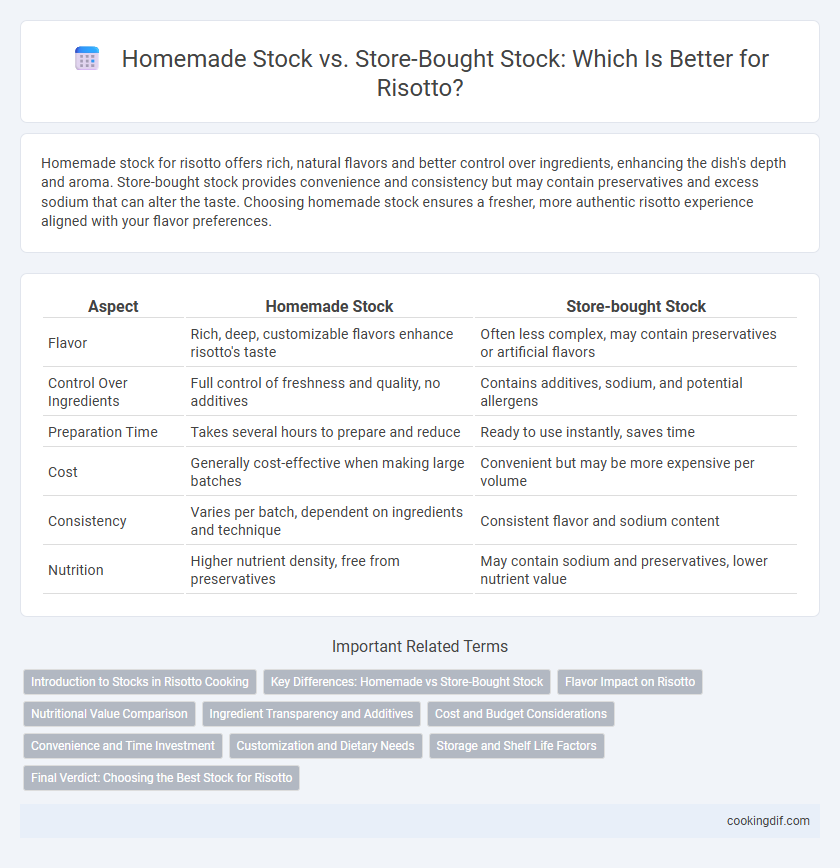Homemade stock for risotto offers rich, natural flavors and better control over ingredients, enhancing the dish's depth and aroma. Store-bought stock provides convenience and consistency but may contain preservatives and excess sodium that can alter the taste. Choosing homemade stock ensures a fresher, more authentic risotto experience aligned with your flavor preferences.
Table of Comparison
| Aspect | Homemade Stock | Store-bought Stock |
|---|---|---|
| Flavor | Rich, deep, customizable flavors enhance risotto's taste | Often less complex, may contain preservatives or artificial flavors |
| Control Over Ingredients | Full control of freshness and quality, no additives | Contains additives, sodium, and potential allergens |
| Preparation Time | Takes several hours to prepare and reduce | Ready to use instantly, saves time |
| Cost | Generally cost-effective when making large batches | Convenient but may be more expensive per volume |
| Consistency | Varies per batch, dependent on ingredients and technique | Consistent flavor and sodium content |
| Nutrition | Higher nutrient density, free from preservatives | May contain sodium and preservatives, lower nutrient value |
Introduction to Stocks in Risotto Cooking
Homemade stock offers a rich, nuanced flavor profile essential for authentic risotto, created through slow simmering of bones, vegetables, and herbs, enhancing the dish's depth. Store-bought stock provides convenience but often contains preservatives and lacks the complexity that homemade stock brings to risotto's creamy texture and balanced taste. Choosing quality, low-sodium store-bought options can be a practical substitute, yet fresh homemade stock remains superior for achieving traditional risotto excellence.
Key Differences: Homemade vs Store-Bought Stock
Homemade stock offers a richer, more complex flavor profile due to the slow simmering of fresh ingredients like bones, vegetables, and herbs, which release natural gelatin and nutrients enhancing the risotto's creaminess and depth. Store-bought stock, while convenient and consistent, often contains preservatives, higher sodium levels, and less pronounced flavors that can result in a less vibrant risotto base. Using homemade stock allows precise control over seasoning and ingredient quality, directly impacting the texture and taste of the final risotto dish.
Flavor Impact on Risotto
Homemade stock enriches risotto with deep, complex flavors derived from fresh herbs, vegetables, and bones simmered for hours, enhancing the dish's richness and aroma. Store-bought stock often contains additives and lower seasoning levels, which can result in a less vibrant taste and a more diluted risotto flavor profile. Using homemade stock intensifies the umami and savory notes, creating a more authentic and satisfying risotto experience.
Nutritional Value Comparison
Homemade stock offers superior nutritional value compared to store-bought options, providing higher levels of collagen, minerals, and vitamins extracted from simmered bones, vegetables, and herbs. Store-bought stock often contains additives, preservatives, and lower nutrient density due to processing methods and dilution. Choosing homemade stock enhances the risotto's flavor profile and increases the intake of essential nutrients like calcium, magnesium, and amino acids crucial for overall health.
Ingredient Transparency and Additives
Homemade stock offers superior ingredient transparency, allowing control over the quality and freshness of components such as fresh vegetables, herbs, and bones, which enhances the depth of flavor in risotto. Store-bought stock often contains additives like preservatives, artificial flavors, and excess sodium, which can alter the delicate balance of the dish. Choosing homemade stock ensures a cleaner, more natural base that complements the creamy texture and subtle ingredients of traditional risotto.
Cost and Budget Considerations
Homemade stock for risotto offers greater control over flavor intensity and ingredient quality while often costing less than premium store-bought options, especially when utilizing kitchen scraps and bones. Store-bought stock provides convenience and consistent taste but can be more expensive per use and may contain additives that affect the dish's final profile. Budget-conscious cooks benefit from homemade stock by reducing purchase frequency and customizing seasoning, ultimately enhancing both cost-efficiency and culinary depth.
Convenience and Time Investment
Homemade stock offers a richer, more complex flavor profile that enhances risotto but requires several hours of simmering and careful ingredient selection. Store-bought stock provides convenience and saves significant preparation time, allowing for quick meal execution without the lengthy cooking process. Choosing between the two depends on balancing flavor quality with time constraints in risotto preparation.
Customization and Dietary Needs
Homemade stock allows precise control over ingredients, ensuring the broth perfectly matches dietary needs such as low sodium or allergy restrictions, enhancing the risotto's flavor and nutritional profile. Store-bought stock offers convenience but often contains preservatives and high sodium levels, which may limit customization for specialized diets. Tailoring homemade stock with fresh vegetables, herbs, and bones creates a richer, more personalized base essential for authentic risotto texture and taste.
Storage and Shelf Life Factors
Homemade stock offers superior flavor and ingredient control but requires refrigeration for up to 4-5 days and can be frozen for 3-4 months, ensuring freshness through proper storage containers. Store-bought stock provides convenience and a longer shelf life, typically lasting several months unopened in a pantry and 4-5 days once opened if refrigerated. Choosing between the two depends on balancing freshness preferences with storage capabilities and shelf life demands for the risotto base.
Final Verdict: Choosing the Best Stock for Risotto
Homemade stock delivers richer depth and complex flavors that elevate risotto's creamy texture and savory profile, making it the preferred choice for chefs seeking authenticity. Store-bought stock offers convenience but often contains higher sodium levels and lacks the nuanced taste that slow-simmered ingredients provide. For the best risotto, investing time in homemade stock ensures a superior umami backbone, enhancing the overall dining experience.
Homemade Stock vs Store-bought Stock for liquid Infographic

 cookingdif.com
cookingdif.com